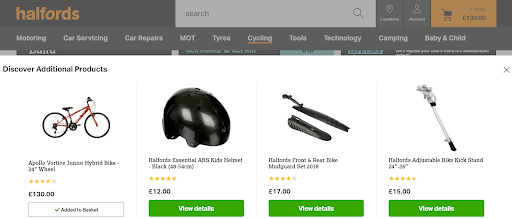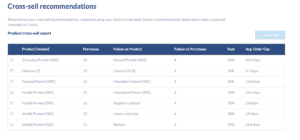TL;DR Providing extra value for customers at various stages of their website experience can drive an increase in revenue, average customer spend and repeat purchases, but it is important to remember that the customer is in control so your focus must be on how to make their experience a positive one
At some point in your life you will have experienced the upsell or cross-sell.
Whether it’s the salesperson trying to entice you with a more expensive upgrade of the car you’re showing an interest in, their attempts at selling you their ultra car washing kit or, simply, your local supermarket offering chewing gum while you wait in the queue for the till – they’re all tactics to encourage you to spend more.
These tactics have transferred to online – and very successfully too. The e-commerce masters, Amazon, have built a hugely powerful engine which displays areas such as ‘frequently bought together’, ‘compare with similar items’ and ‘what other items do customers buy after viewing this item?’
All are techniques to encourage you to buy more, often to buy something more expensive or to buy an alternative which is more suited to your needs.
The last point is, arguably, where the online world is considerably different to the offline world.
A salesperson looking to hit targets can fall into the trap of pushing something on to customers that isn’t right for them. In the online environment, the customer is in control and this is why e-commerce businesses need to be smart in their upselling and cross-selling.
The customer must come first
While Amazon has previously reported that 35% of its revenue comes from cross-selling, the real ingenuity behind their approach is by putting customers first.
‘Frequently bought together’ shows how other customers have shopped and matched related products to their purchase. It’s great cross-selling from Amazon but it’s a customer-first approach.
‘Compare with similar items’ provides customers with the opportunity of researching what’s best for them without needing to scour the internet. It’s great upselling (or downselling) from Amazon but it’s a customer-first approach.
‘What other items do customers buy after viewing this item’ provides customers with a very easy route to looking at alternatives. It’s great upselling and cross-selling from Amazon but it’s a customer-first approach.
And the icing on the cake is that this is completely automated, driven by other customers.
“But they’re Amazon,” I hear you cry. “We can’t do all of that.”
Well, actually, you can adopt a number of such tactics within e-commerce platforms such as Shopify and Woocommerce.
A number of upselling and cross-selling apps are available in the Shopify App Store and plug-ins for Woocommerce.
While there might be some cost attached to these, according to Forrester, product recommendations like upsells and cross-sells are responsible for an average of 10-30% of e-commerce revenues.
Use them well and the return will far outweigh the cost.
Tactics for success
The ‘frequently bought together’ panel is an option for most e-commerce businesses, but it still needs to be implemented correctly.
Again, Amazon just does it right, combining three items and then making it super simple for the customer to buy with one click.

Simply having a panel displaying items which are often bought together isn’t a great user experience and is unlikely to drive cross-sells, as the onus is on the customer to add a product to their basket, then return to a product page and add a second or third product. Again, make sure that your approach is customer-first.
A common technique for cross-selling is to add related products once a product has been added to the cart. Moonpig does this once a card has been designed and added to the basket by displaying items such as flowers and chocolates, in the knowledge that if you’re buying a card then you are likely to be in the market for a gift as well.
Halfords’ website also provides this option with a neat pop-up window.

The only observation here is that you have to click ‘view details’ which takes users to another product page where they then have to add to their basket. Perhaps the option on the pop-up window to ‘Add to Basket’ directly could drive an even greater conversion rate.
It should be obvious, but I’ll say it anyway, that your related products are actually related – avoid adding anything which doesn’t fit with the original purchase and definitely avoid the temptation of throwing in a product because you’re looking to clear old stock.
One other noticeable aspect of the Halfords approach is that the additional products are all relatively low value. You should avoid adding high-price items when cross-selling and you should also offer only a small number of items to prevent them feeling overwhelmed. Again, put the customer first.
Another common e-commerce tactic is to create perceived value – highlighting a deal or waiving of a delivery fee at a certain threshold.
After a product is added to a basket, alert customers to the fact that if they spend a little more they qualify for a free gift or free delivery.
Vaping website Totally Wicked does this although the text would benefit from an increase in point size.

And Nespresso alerts customers to its free delivery threshold within the basket.

While on the subject, it is well worth considering offering free delivery on products. A study in America shows that consumers are now expecting free delivery and, again, it heightens the sense of perceived value.
Other techniques include ‘best-seller’ panels – products which are popular in a given period – and including customer value ratings, commonly through using star icons, when displaying items in a cross-sell.
I have come across suggestions to add related products automatically and force the user to untick a box to remove the items, but I’d urge against this. You might get some short-term gain but consider the potentially negative long-term impact of customers losing trust in you and opting not to return.
Bundles of fun
The final area I’m going to explore is bundles – combining two or more products together, normally with a discount.
Supermarkets are masters of this with their 3-for-2 offerings and there are a number of options available to e-commerce websites.
Women’s cycling experts, VeloVixen, offers a site-wide discount through the use of a code to be added at checkout.

Others will manually create bundles of a few items while some, such as Marks and Spencer, turn them into gift sets.

Once again, the customer value needs to come first.
I’ve seen e-commerce stores throw together bundles with a bunch of products, often with the aim of getting rid of some old stock. They don’t really make much sense and are more often than not a massive waste of time and effort because the customer didn’t come first.
Leverage your data and cross sell directly via SMS
Are you tired of guessing which products you should be cross selling?


Summary
The tactic of upselling and cross-selling should be a priority for e-commerce websites, both for the added revenue but most importantly for the extra customer value it can provide.
If you are manually pushing upsell or cross-sell suggestions, it’s worth considering automating the process, but only if you stock a considerable number of products.
Products can be categorised and related products tagged to allow automation to work for customers, but you might find that you’d prefer to do this manually, especially if your product range is relatively small.
Whichever route you choose, always remember: the customer comes first.



